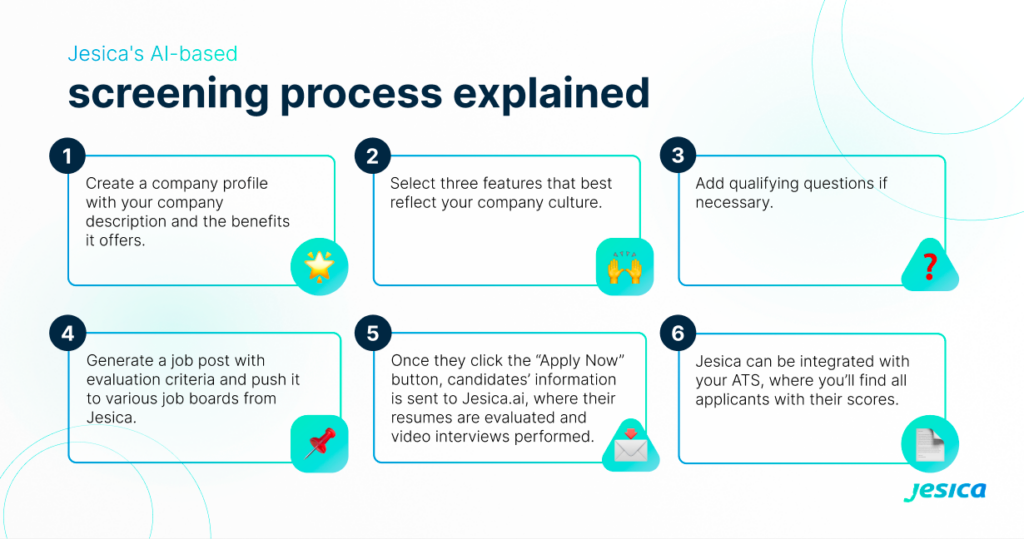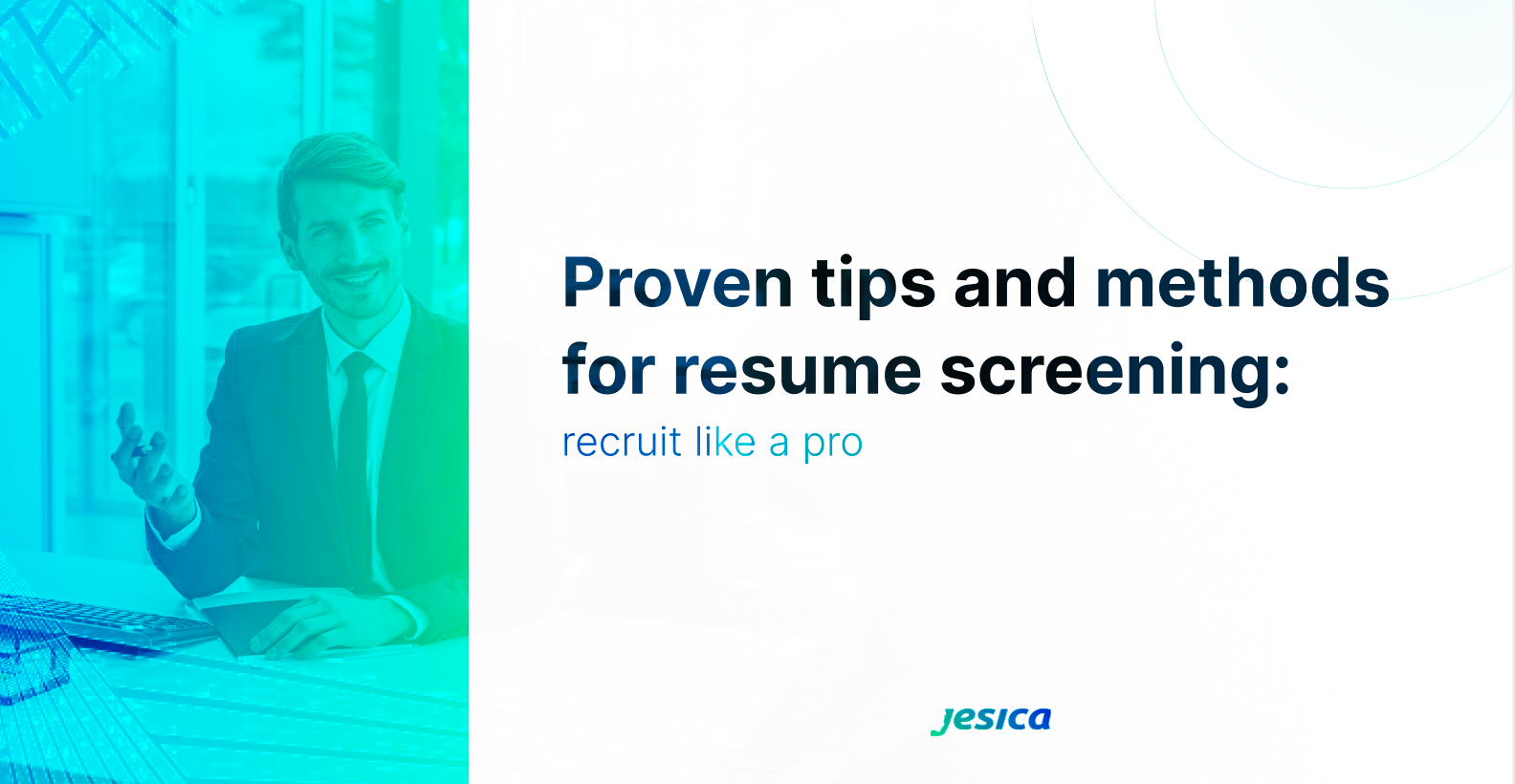Candidate screening allows employers to save time and costs by rejecting unqualified candidates early in the hiring process, as well as ensuring better quality of hires. However, resume screening is associated with a number of difficulties. Beyond being a time-consuming process, it’s often inefficient due to many factors.
Luckily, there are several proven methods for resume screening that help tackle challenges, saving HR teams time and helping them make more informed decisions. Read on to learn the top tips for screening resumes and find out how to screen a resume in just a few seconds with Jesica.ai.
Interested? Let’s get down to business.
What is resume screening?
Resume screening is a stage of the recruitment process that aims at determining whether an applicant is qualified for a role by checking resumes for skills, qualifications, and experience necessary to perform the job successfully.
This helps narrow down the candidate pool to a more manageable size, allowing HR professionals to focus on the most promising applicants.
The resume screening process involves assessing various aspects of resumes, including education, work experience, skills, employment gaps, achievements, cultural fit, and industry experience.
The most common methods for resume screening
Basically, there are two major methods of screening candidates: your HR team can either check resumes manually or use specialized resume screening software like Jesica.ai.
Manual screening is a lengthy process, while different screening software can use diversified approaches and technologies, providing varying levels of quality.
That’s how Jesica.ai significantly streamlines the process by reducing the screening time by up to 80%, helping identify your best candidates in just 1 hour.
How to screen a resume: 9 essential steps
So, how are resumes screened? Well, the process involves multiple steps, including:
- Reviewing a job description that outlines the necessary skills, qualifications, and experience needed for the role.
- Developing a scoring system or checklist to evaluate each resume objectively.
- Sorting resumes into qualified and unqualified.
- Scanning for key information, such as work experience, educational background, skills, certifications, and accomplishments.
- Assessing work history (job titles and responsibilities, duration of employment at each job, career progression).
- Verifying qualifications to ensure that the candidate possesses the necessary degrees, certifications, or licenses required for the job.
- Identifying cultural fit to make sure the candidate’s values align with the company culture.
- Comparing resumes against the established scoring system to determine the most suitable candidates.
- Conducting further assessments to get a clearer sense of the candidate’s communication skills and cultural fit.
Challenges of resume screening
While resume screening is a critical stage of the hiring process, it involves certain challenges that can significantly complicate the task of identifying the best-fit candidates. Some major challenges include:
- Massive numbers of resumes: Job postings usually trigger high volumes of resumes, attracting an average of 250 applicants. Checking hundreds of resumes is not only time-consuming but can also be overwhelming and exhausting, reducing the quality of work.
- Time constraints: HR professionals often have limited time to review resumes, which can result in performing rushed evaluations and overlooking qualified candidates. Imagine performing the above 9 tasks in 6-8 seconds per resume, which is the average industry trend these days.
- Lack of objective criteria: Without well-defined, objective criteria for evaluating resumes, it’s challenging to identify the most suitable candidates consistently.
- Insufficient resumes: Some applicants submit generic resumes, making it difficult to determine whether they possess the right skills and experience. Still, these resumes take time and effort to process.
- False information on resumes: Candidates may make exaggerated claims on their resumes. Verifying qualifications and achievements can be challenging, and you might only discover the reality further on in the process.
- Unconscious bias: Whether based on gender, ethnicity, race, educational background, or any other factors, unconscious bias can adversely affect resume evaluation, leading to unfair treatment of applicants or overlooking suitable candidates. That’s how, according to Harward Business Review, 85%-97% of recruiters rely on intuition when selecting potential employees.
6 tips on how to streamline resume screening process
Obviously, challenges that occur in the resume screening process can significantly impact the quality of hires. However, you can overcome most of those pitfalls by using Jesica.ai in combination with these tried-and-true tips for screening resumes.

- Start with clear job requirements
It’s imperative to have a well-defined job description before you start screening resumes. During the intake, work closely with your team to come up with a clear outline of the qualifications, skills, and experience necessary for the role.
A precise role description will serve as a guide when reviewing resumes, making it easier to identify candidates who meet your specific criteria.
- Set selection criteria
Based on the role description, create a list of necessary skills, dividing them into must-haves and nice-to-haves. Also, make sure you incorporate your culture’s must-haves. This will allow you to quickly compare candidates, creating a shortlist of those who possess a more suitable set of skills.
The candidates’ cultural alignment is crucial for effective collaboration and creating a cohesive work environment. While this aspect is easy to overlook when screening resumes manually, artificial intelligence comes to save the day.
Our AI-based tool, Jesica, offers to select your company culture once, at the moment of creating your company profile and uses this setting when selecting the top fits for your open roles every time.
- Consider a rating system
One of the ways to streamline resume screening is to introduce a rating system and rank or tag CVs based on their relevance to the role. For example, you can sort resumes into Yes, No, and Maybe groups or invent a more complex system.
A word of advice: Never hurry to delete the Maybe resumes. These candidates can be good fits for other roles in the future.
- Fact check
Let’s face it: Candidates can sometimes be dishonest about their education, experience, or achievements. The good news is that you can check most of this information online. Of course, it would be a waste of time to fact-check the resumes of applicants you are not going to proceed with, but make sure you check the candidates you’re looking to move further down the pipeline.
This takes time, however, innovative AI-powered tools can enhance humans in this job. For example, Jesica can check your candidates by means of video interviews, saving you time and ensuring high quality.
- Don’t get misled by keywords
While searching for keywords was considered one of the best resume screening techniques for years, it doesn’t look like a good idea in 2023. This practice has hugely impacted resume creation — hoping to get a job, people started to use keywords widely in resumes to get noticed.
It’s important to understand that most screening applications focus on keywords, resulting in candidate shortlists similar to those you’d come up with if you searched for keywords manually. The good news is that Jesica uses complex LLM (large language model) technologies to analyze resumes holistically rather than just look for keywords.
- Use modern technology
While the above tips can apply to manual CV screening, they can’t ensure the speed, quality, and efficiency provided by AI screening tools.
Essentially, screening software compares resumes against the job requirements, shortlisting the most suitable applicants. However, unlike manual resume screening methods, AI-driven resume screening isn’t affected by bias or fatigue, reducing the risk of overlooking qualified candidates or missing important details.
Unlock the most efficient resume screening with Jesica.ai
We are proud to introduce an innovative AI-powered tool for candidate screening. Meet Jesica, a virtual screening assistant that will help overcome all your screening challenges in a matter of clicks.
How Jesica.ai works
A user-friendly tool built with HR needs and pain points in mind, Jesica can automate your screening process with minimal input from your side. Here’s what the process of resume screening with Jesica.ai looks like:
- You start by creating a company profile, which should include your company description and the benefits it offers.
- Next, select three features that best reflect your company culture.
- If you have legal or logistical criteria you’d like to filter for, add qualifying questions.
- Generate a job post with evaluation criteria and push it to various job boards from Jesica.
- Once they click the “Apply Now” button, candidates’ information is sent to Jesica.ai, where their resumes are evaluated and video interviews performed.
- Jesica can be integrated with your ATS, where you’ll find all candidates who applied for the job, with the top 10 highlighted with details of their scores.

Why Jesica?
Extensive experience in hiring management allowed us to create Jesica with all screening challenges considered. Let’s take a look at what our tool offers:
- Unprecedented speed: Jesica reduces screening time by 80%, dramatically accelerating the screening process. It’s impossible to achieve such efficiency using manual resume screening techniques.
- 24/7 efficiency: Jesica works nonstop and never gets tired. Our clients have already managed to save 45% of cost per hire on average.
- High precision: Advanced algorithms allow the tool to process multiple dimensions of each interview and resume, moving only the top candidates further. Jecisa filters out up to 97% of applicants who aren’t suitable for the role.
- The best possible quality of hire: Jesica’s sophisticated algorithms enable selecting the best fit for each role.
- Stellar ROI: Assuming there are 400 candidates for one position, Jesica can ensure a 708% ROI.
- Unbiased decision-making: Our tool makes entirely fair assessments, eliminating bias related to ethnicity, race, appearance, gender, age, etc.
- Full legal compliance: We take candidates’ and employers’ privacy seriously. Jesica follows all international, North American, and European compliance regulations.
- Pricing flexibility: We offer several subscription plans to cater to the needs of any company, from small businesses to large enterprises.
Identify the best candidates in a couple of minutes with Jesica.ai!
Candidate screening is a complex and time-consuming task that requires intense concentration and a meticulous approach.
While you can use resume screening tips to streamline the manual process, you won’t be able to achieve the speed, precision, and efficiency of AI-based screening tools like Jesica. Explore the impressive potential of artificial intelligence today — request a demo to see what Jesica can do for you!
